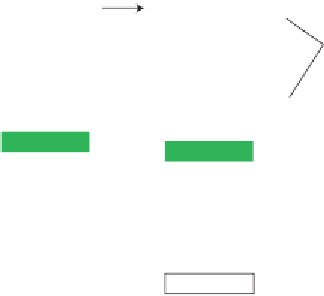Environmental Engineering Reference
In-Depth Information
Rate determining
H
2
+ O
2
Au
HOOH
Au
Au
slow
C
3
H
6
O
medium
H
2
O
C
3
H
6
+
+
Au
OH
OH
CH
2
OH
CH
3
Ti
Ti
OH
OH
OOO
fast
OH
OH
Ti
Ti
OOO
Ti
Ti
OOO
Au
medium
o.a. CO
2
, CH
3
CHO
O
2
O
OH
CH
2
CH
3
+
C
Very slow
OH
OH
OH
OH
Ti
Ti
Ti
Ti
O
OOO
Deactivation
Figure 8.10
Schematic representation of the model of reaction and deactivation for the
propene epoxidation over gold-titania catalysts. Reproduced with permission from [76].
supported gold nanoparticle catalyst. h e hydrogen ei ciency is dei ned as
“moles of PO formed/moles of Hydrogen converted.” h e higher hydrogen
ei ciency demands more attention as it shows the green route for propyl-
ene epoxidation reaction. A target for 50% hydrogen ei ciency was set for
commercialization of the PO production process. Uphade
et al
. used CsCl
promoter in the Au/Ti-MCM-48 catalyst to suppress the hydrogen com-
bustion for water formation (Figures 8.11 and 8.12).
It is found by Chowdhury
et al.
that a small amount of trimethylamine
can cover some small portion of bare gold surface, thereby improving the
hydrogen ei ciency. It has been investigated that the local heat produced
in the catalyst bed is responsible for hydrogen combustion reaction. So use
of thermal conducting material like silicon carbide would be very ef ective
for decreasing hydrogen combustion reaction.
Though it is a dream path, the synthesis of PO by direct epoxidation
of propylene using molecular O
2
is a green and sustainable route; how-
ever, until recently the initiated work has not been successful. Quite
recently, a breakthrough discovery by Haruta
et al.
using gold nano-
cluster catalyst in the size range of less than 2 nm was able to produce
propylene epoxide in the presence of molecular O
2
[78]. It was found
that the deposition-precipitation method was more effective in prepar-
ing gold nanoparticles of 2-5 nm size. However. the gold nanocluster



































Search WWH ::

Custom Search